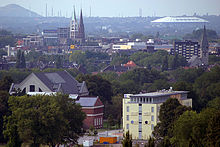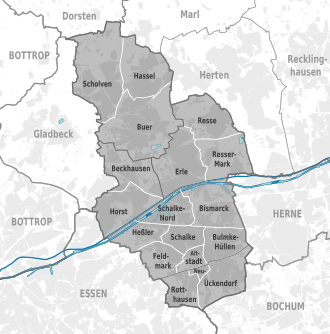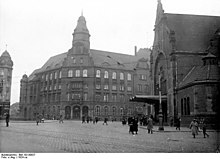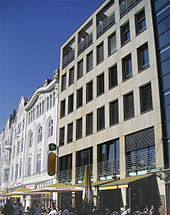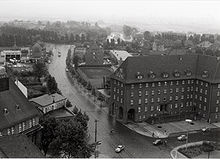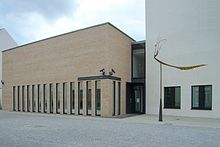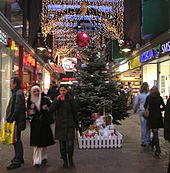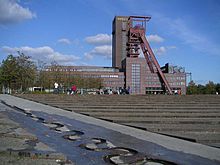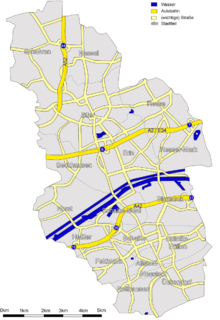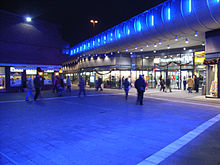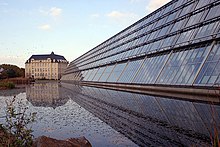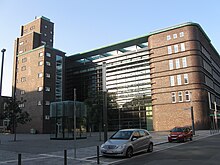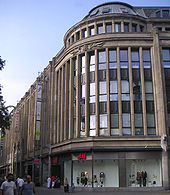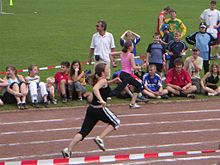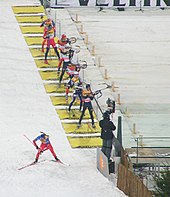Gelsenkirchen
| coat of arms | Germany map | |
|---|---|---|

|
Coordinates: 51 ° 31 ' N , 7 ° 6' E |
|
| Basic data | ||
| State : | North Rhine-Westphalia | |
| Administrative region : | Muenster | |
| Height : | 48 m above sea level NHN | |
| Area : | 104.94 km 2 | |
| Residents: | 259,645 (Dec. 31, 2019) | |
| Population density : | 2474 inhabitants per km 2 | |
| Postcodes : | 45879-45899 | |
| Area code : | 0209 | |
| License plate : | GE | |
| Community key : | 05 5 13 000 | |
| LOCODE : | DE GEK | |
| NUTS : | DEA32 | |
| City structure: | 5 districts with 18 districts | |
City administration address : |
Ebertstrasse 11 45879 Gelsenkirchen, Germany |
|
| Website : | ||
| Lord Mayor : | Frank Baranowski ( SPD ) | |
| Location of the city of Gelsenkirchen in North Rhine-Westphalia | ||
Gelsenkirchen [ ɡɛlzn̩ˈkɪrçn̩ ] is a city in the central Ruhr area in North Rhine-Westphalia and belongs to the Rhine-Ruhr metropolitan region . The independent city in the Münster administrative district is designated as a medium-sized center in state planning . It is a member of the Regional Association of Westphalia-Lippe and the Regional Association of Ruhr . In Germany and beyond, Gelsenkirchen is primarily known as the home of the FC Schalke 04 football club and for the mining industry at the time .
The city in its current boundaries is the result of several regional reforms , through which some surrounding communities and also larger cities, including the former metropolis (since 1926) Buer (since 1912 city Buer) and the district of Horst - formerly the Freedom Horst , since 1891 office Horst - incorporated into Gelsenkirchen or merged with this city. Even with the first major incorporation in 1903, Gelsenkirchen's population was above the 100,000 limit, which made it a major city. Today Gelsenkirchen, with around 260,000 inhabitants, ranks eleventh out of the state's 29 major cities. Gelsenkirchen used to be known as the city of 1000 fires because of the many torches that the coking plants used to dispose of the excess coke oven gas . Since the 1960s there has been a structural change from the coal and steel industry to a knowledge and service economy .
Geography and climate
Gelsenkirchen is located on the flat slopes of the wide Emscher Valley with the Rhine-Herne Canal running parallel here in the southwest of Westphalia. The core city lies south of the river or canal, while the boroughs Horst and seven boroughs that emerged from Buer lie north of the waters. A large part of the urban area lies below the main receiving water Emscher due to mountain subsidence and therefore has to be constantly protected from flooding by the Emschergenossenschaft with drainage pumps.
The largest extension of the urban area is 17 kilometers in north-south direction and 11 kilometers in west-east direction. The city limits have a total length of 68 kilometers.
In Gelsenkirchen, around ten percent of the urban area is park and leisure areas and 25% forests and agricultural areas. Gelsenkirchen is one of the cities with an above-average proportion of green space.
Gelsenkirchen is located in the largest polycentric conurbation in Germany, the Rhine-Ruhr metropolitan region .
Neighboring communities
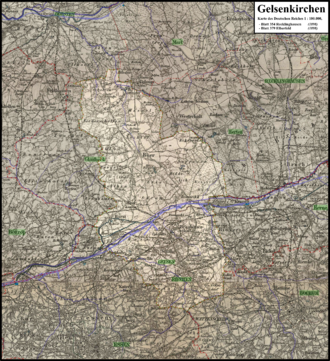
The following cities border the city of Gelsenkirchen in a clockwise direction, starting in the east: The independent cities of Herne , Bochum and Essen as well as the cities of Gladbeck , Dorsten , Marl and Herten belonging to the Recklinghausen district .
Exclave
Gelsenkirchen has a two-hectare exclave at the point where the Hüller Bach forms the city boundary between Bochum and Herne. This belongs to the Ückendorf district .
City structure
The urban area of Gelsenkirchen consists of five urban districts , each with a district representative , which are divided into districts . The city districts with associated districts:
- Gelsenkirchen-Nord: Buer , Scholven , Hassel
- Gelsenkirchen-Mitte: Old Town , Bismarck , Bulmke-Hüllen , Feldmark , Heßler , Schalke , Schalke-Nord
- Gelsenkirchen-West: Horst , Beckhausen
- Gelsenkirchen-Ost: Alder , Resse , Resser Mark
- Gelsenkirchen-Süd: Neustadt , Ückendorf , Rotthausen
The boundaries between the districts, with the exception of the northern boundary , form various elements of the city's transport infrastructure. The Herne-Oberhausen railway line separates the districts center and south , the Rhine-Herne Canal center and west or east, and Kurt-Schumacher-Strasse east and west .
The districts south with about 7.8% (or 9.11% in relation to the district area) and east with 8.9% have the smallest share of the industrially and commercially used area of the city of Gelsenkirchen . On the other hand, one can still recognize the industrial past in the district of Mitte with a share of 37% of the industrially used urban area (or 16% of the district). In the north and west urban districts, the figures of 31% and 15% (in relation to the industrially used urban area) reflect the large amount of space used by the BP refineries there .
The three districts north , east and west are used equally for agriculture with around 20% of the respective district area, with 42% of all agricultural areas in the city in the north district alone . The city districts middle with only 5% and south with 11.9% share of the district area are at the bottom. The forest land use is greatest in the East District ( 14% ) (the Resser Mark forest area). In relation to the entire urban area, as much as 40% of all forestry areas are in the East District .
While a certain agricultural and forestry character is noticeable in the north and east of the city as well as in the Beckhausen district, the mining and industrial past of the city with associated residential developments can be seen especially south of the Rhine-Herne Canal , even if only a few buildings are reminiscent of the former Holland, Rhein-Elbe and Hibernia collieries and the Thyssen cast steelworks.
Today's districts vs. Markings
The three districts north , west and east located north of the Emscher largely correspond to the old Buer office in Vest or Recklinghausen district minus the offices of Gladbeck (split off in 1885, today's city of Gladbeck ) and Westerholt (independent in 1911; part of Herten since 1975). Horst also resigned from Buer in 1891, but was merged with Gelsenkirchen together with the city of Buer in 1928, after Horst had previously sought to join Buer for economic reasons. Within the three northern city districts there are only the districts Horst (5128) and Buer; within the latter are all other parts of the city north of the Emscher (as well as that part of the BP Öl site that is part of today's Horst district).
The following districts exist south of the Emscher:
- Hessler
- Bismarck
- Schalke
- Gelsenkirchen
- Bulmke cases
- Rotthausen
- Ückendorf
The new district of Schalke-Nord is not, as the name suggests, mainly in the Schalke district, but mainly occupies the northeast of the Heßleraner and the west of the Bismarck district. It justifies its name primarily through the Schalke train station and the Glückauf-Kampfbahn in its south, which have always been in the Hessleran area.
The new district of Feldmark occupies the north-west of the Rotthausener, the south-west of the Schalke district and, to a lesser extent, the south of the Hessleran district. Most of the residents of the district live in the old Schalke area, as the major part of the part taken over by Rotthausen is taken over by the Trabrennbahn and Halde Zollverein.
The city center, today divided into old and new town, grew a little to the west into the Rotthausen district, but in the north a significantly larger part was ceded to Schalke. Ückendorf took over some areas in the north from the now united Bulmke and Hüllen, which in turn took over areas from Bismarck in the north.
Climate diagram
| Gelsenkirchen station Essen-Bredeney | ||||||||||||||||||||||||||||||||||||||||||||||||
|---|---|---|---|---|---|---|---|---|---|---|---|---|---|---|---|---|---|---|---|---|---|---|---|---|---|---|---|---|---|---|---|---|---|---|---|---|---|---|---|---|---|---|---|---|---|---|---|---|
| Climate diagram | ||||||||||||||||||||||||||||||||||||||||||||||||
| ||||||||||||||||||||||||||||||||||||||||||||||||
|
Average monthly temperatures and rainfall for Gelsenkirchen
Station Essen-Bredeney
Source: DWD, data: 2015–2020
|
|||||||||||||||||||||||||||||||||||||||||||||||||||||||||||||||||||||||||||||||||||||||||||||||||||||||||||||||||||||||||||||||||||||||
history
Middle Ages and Early History
Although the current district of Buer was first mentioned in a document by Heribert I as Puira (probably a failed Buira ) in 1003 AD , it existed on the hill north of the Emscher as early as the Bronze Age , i.e. more than a thousand years before Christ , some hunting peoples (Germanic Brukterer ?) who did not live there in settlements, but in individual farms close to one another. Later the Romans invaded the region. The Saxons settled the area around 700 AD . Some other parts of the city that are located in northern Gelsenkirchen today were also mentioned in the early Middle Ages ; some examples are Raedese (today the Resse district ), Middelvic ( Middelich ; today part of the Resse district) or Sutheim (Sutum) and Sculven (today the Scholven district ). Many farmers were later localized with the name iuxta Bure (near Buer).
The name Gelstenkerken or Geilistirinkirkin appeared for the first time around 1150 . The first spelling means something like church among the settlers (-seten) in the Bruchland (gel). The second variant was translated by Franz Darpe with the church (by the brook) of the lush bulls and by Paul Derks with the church on the square, where horny bulls romped about . The named church probably referred to the Gelsenkirchen village church, one of the predecessor buildings of the St. Georg church . However, the patron saint St. George has nothing to do with the first part of the city name. Around the same time, the first church was built in the north of today's urban area in the Buer district; This ecclesia Buron (church to Buer) was listed in 1160 in a directory of parish churches of the Deutz sexton Theodericus. The settlement belonged to Vest Recklinghausen . However, only a few dozen people lived in the settlements around the Emschermulde in the early days and in the Middle Ages. The areas south of the Emscher of today's city of Gelsenkirchen, however, belonged to the County of Mark , which had been part of Prussia since 1666 (provisional from 1609) .
From 1609 to 1706, 15 people were persecuted by witches in the area of today's city of Gelsenkirchen . Anna Spiekermann , born in Gelsenkirchen-Buer (Sutum peasantry), was executed on July 31, 1706 in Westerholt . She was the last victim of the witch hunts in Vest Recklinghausen.
In the witch trials in the Horst Freedom (Gelsenkirchen-Horst) 14 people got into witch trials, six were executed. In 1609 the children Greitgen Nothoff, Johann Nothoff and the 8-year-old Trina Nothoff were expelled from the rule. Her parents Johann Nothoff and Hille Nothoff were strangled and then burned.
industrialization
Until the middle of the 19th century, the area in and around Gelsenkirchen was only sparsely populated and almost exclusively agricultural. In 1815 today's urban area of Gelsenkirchen - after temporarily belonging to the Grand Duchy of Berg - went to Prussia, which incorporated it into the province of Westphalia . While the former Gelsenkirchen office Wattenscheid in the circle Bochum the governmental district Arnsberg was assigned to the Office Buer (Horst) came to the district of Recklinghausen in the administrative district of Münster . This assignment to two administrative districts did not end until 1928.
After the discovery of hard coal in 1840 and the subsequent industrialization, the main line of the Cologne-Minden Railway Company and the first Gelsenkirchen station were opened in 1847 . In 1868 Gelsenkirchen became the seat of its own office in the Bochum district. These included the communities of Gelsenkirchen, Braubauerschaft (from 1900 Bismarck), Schalke, Heßler, Bulmke and Hüllen. Friedrich Grillo founded the stock corporation for the chemical industry and the Schalker mine and smelter association in Schalke in 1872 . A year later he founded the Glas- und Spiegel-Manufaktur AG , also in Schalke . After Gelsenkirchen had become an important location for heavy industry , it was granted city rights in 1875 .
Gelsenkirchen becomes a big city
In 1885, after the Bochum district was divided, Gelsenkirchen became the seat of its own district, which was to exist until 1926. The district of Gelsenkirchen included the cities of Gelsenkirchen and Wattenscheid as well as the offices of brewing farmers (from 1900 Bismarck), Schalke , Ückendorf and Wanne . A few years later, on April 1, 1897, Gelsenkirchen left the Gelsenkirchen district and became an independent city . Horst left the Buer office in 1891.
The irresponsibility of the water supply operators led to the typhus epidemic in Gelsenkirchen in 1901 .
Gelsenkirchen main station was opened on July 1, 1907 , because the old station no longer had enough capacity due to the strong population growth. In the course of industrialization, many Polish-speaking workers had moved from the Posen Province , which in 1905 made up 13.9% of Gelsenkirchen's city population. Buer was in 1911 declared a town and a year later acyclic ; Westerholt , which had previously belonged to the Buer office , became the seat of its own office. In 1924 the rural community of Rotthausen, which until then had belonged to the Essen district, came to the city of Gelsenkirchen.
The Deutsche Reichsbahn-Gesellschaft built the Gelsenkirchen-Bismarck depot from 1924 to 1926 , which was in operation until 1981. In the course of the Prussian territorial reform on April 1, 1928, the cities of Gelsenkirchen and Buer were merged with the Horst office to form the new independent city "Gelsenkirchen-Buer". Since then, the entire urban area has belonged to the Münster administrative district . In 1930 the name Gelsenkirchen-Buer was amended by the City Council with effect from 21 May in Gelsenkirchen changed. The city was now home to around 340,000 people in the new constellation.
Gelsenkirchen at the time of National Socialism
During the time of National Socialism , Gelsenkirchen was one of the centers of the arms industry due to its location in the heart of the Ruhr area . In the mid-1930s, Hibernia AG built the Scholven hydrogenation plant as a subsidiary , where synthetic gasoline was produced by liquefying coal . In the same year 1936 the Gelsenkirchener Bergwerks-AG founded the Gelsenberg Petrol AG in Horst and produced petrol from coal there from 1939. Both plants are now part of BP Gelsenkirchen . In no other time was the production of the Gelsenkirchen industry so high. On the one hand, after the rationalization of many jobs in the 1920s, this created more jobs in mining and heavy industry for a short time; on the other hand, Gelsenkirchen became the target of Allied bombers during the Second World War , who took three quarters of the city area in the air raids on the Ruhr area destroyed. Many former bunkers can still be found in the cityscape today. In addition to the town hall in Buer, an air raid shelter is partially preserved in its original state; in the course of the gutting of the Hans Sachs House, the remains of the bunker were removed.
The football club FC Schalke 04 adapted to the political situation, but was not active in the Nazi regime.
Adolf Hitler only visited Gelsenkirchen once - at the funeral of industrialist Emil Kirdorf , which took place in July 1938 on the grounds of the Rheinelbe colliery in Gelsenkirchen-Ückendorf .
In Gelsenkirchen, too , the synagogue in the Buer district was burned down by the National Socialists in November 1938 , and the synagogue in downtown Gelsenkirchen was also destroyed. Exactly 66 years later, the foundation stone for the new synagogue, inaugurated on February 1, 2007, was laid there.
In 1944 there was a satellite camp of the Buchenwald concentration camp in Gelsenkirchen-Horst . The Gelsenberg camp on the premises of Gelsenberg Petrol AG housed around 2000 Hungarian women and girls who were used for forced labor at the hydrogenation plant. About 150 of them were killed in the bombing raids on Gelsenberg Petrol AG on September 11, 1944. They were forbidden from entering bunkers and protective trenches.
From the surgeon Rudolf Bertram , who from 1937 looked after the hospital in Rotthausen and the St.-Josefs-Hospital in Gelsenkirchen-Horst, it is recorded that he, together with the hospital carer Ruth Theobald and the religious sister Epimacha, 17 seriously injured Jewish women before they were transported to Sömmerda rescued to the Buchenwald subcamp there, which had been brought to Gelsenkirchen hospitals after the bombing raids. Thanks to the work of Bertram and many other hospital employees, these women and girls were liberated in April 1945 in the Marienhospital in Rotthaus. For this act of humanity, Bernhard Rudolf Bertram was posthumously awarded the Righteous Among the Nations award by the Israeli Yad Vashem memorial in 1980 . Bertram remained chief physician at St. Josefs Hospital until his retirement in 1965 and died in Gelsenkirchen in 1975. In 1996, in his honor, a stele with a memorial plaque was set up in front of the St. Josefs Hospital in Gelsenkirchen-Horst , commemorating the events. The square in front of the hospital was named Rudolf-Bertram-Platz .
The area north of the Rhine-Herne Canal was occupied by the US Army at the end of March. The part of Gelsenkirchen south of the canal was not occupied until April 10, 1945. Elsewhere in Germany, the war continued until the beginning of May. The Second World War finally ended on May 8th with the unconditional surrender of the Wehrmacht . The documentation center "Gelsenkirchen under National Socialism" is located at Cranger Str. 323 in the Erle district .
post war period
After the extensive destruction of the city and its industry in the Second World War , the Hassel coking plant went into operation on December 17, 1953 as Germany's first new coke plant after the war.
With the introduction of postcodes in 1961, Gelsenkirchen was one of the few cities to have two postcodes: Gelsenkirchen 465 and Buer 466 (both in use until July 1, 1993). The first comprehensive school in North Rhine-Westphalia was established in Gelsenkirchen in 1969. The Scholven-Chemie AG (formerly hydrogenation plant Scholven) merged in 1975 with the Gelsenkirchen-Benzin-AG to the VEBA Oel AG .
Gelsenkirchen was an important location for the clothing industry. This was once one of the five pillars of the local economy. The steep ascent began in the 1950s and 1960s, this is also shown by the former station window that can be seen today at the foot of Bahnhofstrasse. Around 50 companies, such as Kemper KG, Nienhaus & Luig, Marcona, Harald Feigenhauer, Hugo Kogge, Napieralla & Sons, Schreck and Witschel & Markmann, offered work for over 6,000 employees in the early 1950s. Short-time working began in 1958 and five companies had to close. At the beginning of the 1970s, the oil crisis and the resulting almost unaffordable synthetic fibers fell victim to other companies.
Between 1979 and 1981 the Heinze women became known nationwide. The employees of a Gelsenkirchen photo company fought for the same pay as their male colleagues in court.
During his visit to the Federal Republic of Germany, Pope John Paul II celebrated Holy Mass on May 2, 1987 in the Park Stadium in front of 85,000 people . He accepted the offered honorary membership in FC Schalke 04 .
Until well into the time of the mining and steel crises , there were and are large manufacturing companies from this industrial sector in Gelsenkirchen, including the Schalker Eisenhütte machine factory that still exists today and the cast steelworks of Thyssen AG.
In the 1990s, the restructuring of the economy and the city itself became visible in Gelsenkirchen - later than in some other cities in the Ruhr area. In 1997, the Federal Garden Show (BUGA) took place on the site of the disused Nordstern colliery , which transformed the former colliery site into a landscape park. Two years later, the final of the inter-city IBA Emscher Park , which began in 1989, took place.
The Hassel coking plant produced coke for the last time on September 29, 1999. With the closure, the last coking plant in Gelsenkirchen's urban area ceased production. Until then, coke had been produced in Gelsenkirchen for 117 years and 12 days. In the same year Shell Solar Deutschland AG started the production of photovoltaic systems . With the closure of the last colliery in Gelsenkirchen, the Ewald Hugo colliery , 3,000 miners were laid off on April 28, 2000.
The Buer district celebrated its 1000th anniversary in 2003 and FC Schalke 04 celebrated its 100th anniversary on May 4, 2004.
In 2015, Gelsenkirchen hit the headlines in the youth welfare office scandal because of the personal links between the youth welfare office and a children's home in Hungary.
City films
Between 1951 and 1996 the city of Gelsenkirchen regularly produced film chronicles of the year, 34 of which have been preserved and are also available in digital form. The political, cultural and social development of Gelsenkirchen was documented in the city films.
Religions
Denomination statistics
According to the 2011 census , in 2011 30.1% of the population were Protestant , 33.7% Roman Catholic and 36.3% were non-denominational , belonged to another religious community or did not provide any information. The number of Protestants and Catholics has fallen since then and at 48%, people who do not belong to any legally or corporately constituted religious community are almost the majority of the population. Currently (as of June 30, 2020) of the 264,314 inhabitants, 23.5% are Protestant, 28.4% Catholic and 48.1% are non-denominational or have another denomination.
Judaism
There is a Jewish community in Gelsenkirchen that has grown in recent years due to the influx of a large number of emigrants from the Soviet Union and the Russian Federation . Today the Gelsenkirchen Jewish Community has around 400 members. During the Reichspogromnacht , Nazis destroyed Jewish shops, apartments and cemeteries and set synagogues on fire all over the German Reich . The synagogue in Gelsenkirchen, which was inaugurated in 1885, burned to the ground at that time. Since 1963 a warning plaque commemorated the destruction of the old synagogue . In 1993, the site was finally renamed the place of the old synagogue and 66 years later, on November 9, 2004, Paul Spiegel laid the foundation stone for the new synagogue . The house was officially opened on February 1, 2007. The new center of the Jewish community was built on the site where the old synagogue, which was destroyed in 1938, was located. The prayer room offers space for a total of 400 believers, and a community center with an event room is also connected.
Christianity
Of the population (as of December 31, 2016), 85,002 (30.6%) were Catholic. At the end of 2018, only 80,027 of the residents were Catholic
When Essen was founded, Gelsenkirchen had the same ecclesiastical conditions as the mother church in Essen itself from the very beginning. H. the church belonged to the Archdiocese of Cologne and was subordinate to the dean's office in Essen. With the transition to the county of Mark , the Gelsenkirchen pastor was subordinate to the dean of Wattenscheid . The churches in Buer and Horst were assigned to the dean of Dorsten . In Gelsenkirchen at the beginning of the 17th century the Reformation according to the Lutheran confession prevailed, but the Catholics were still able to use the only church in the city (St. George, today Old Town Church ) ( simultaneous church ) until the end of the 19th century . At the beginning of the 17th century, a reformed community also emerged. The proportion of Protestants and Catholics in Gelsenkirchen was relatively balanced. Buer and Horst remained catholic as places of the Vests Recklinghausen . Protestant parishes only emerged here when people moved in in the 19th century. But the proportion of the total population never exceeded a third.
The Protestant parish of Gelsenkirchen belonged to the Bochum Synod until the end of the 19th century , but in 1892 the city became the seat of its own superintendent or a district synod for the entire surrounding area. This later became the church district of Gelsenkirchen and Wattenscheid, which today includes 22 Evangelical parishes in the city of Gelsenkirchen and the neighboring Wattenscheid district of the city of Bochum within the Evangelical Church of Westphalia . The northern evangelical parishes consist of Buer with 8900 members, Markus parish Hassel with 1950 and Scholven with 3350 members. You want to join forces in 2007 to form a large congregation.
The Catholics in Gelsenkirchen were able to use the Church of St. George together with the Protestants until the middle of the 19th century. Due to the strong growth of the community, however, the building of a separate church was necessary. This is how the Augustine Church was built in 1845. But because it was soon too small, today's St. Augustine Church was built between 1874 and 1884 , which in 1904 was elevated to a provost church by papal decree . In 1905, 47.3% of the residents in Gelsenkirchen were Protestant and 51.2% Catholic.
The provost church became the mother church of several other Catholic churches in the city. Heavily destroyed by bombs during the Second World War in 1944, the Augustine Church was rebuilt from 1948 to 1952 and has since been restored several times. The parishes of Gelsenkirchen belonged to the (arch) diocese of Paderborn from 1821 . The city became the seat of a deanery. The parishes in Buer and Horst belonged to the diocese of Münster from 1821 . While Buer became the seat of its own deanery, Horst belonged to the deanery in Gladbeck. In 1955 the parish church of Sankt Urbanus in Buer was appointed provost church . When the diocese of Essen was founded in 1958 , all parishes in the city of Gelsenkirchen came to this new diocese. Today they form the Gelsenkirchen City Deanery.
Both the Protestant and the Catholic Church run a number of larger social institutions in Gelsenkirchen, especially in the health sector. These include the Evangelical Clinics in the center of Gelsenkirchen and the headquarters of St. Augustinus Gelsenkirchen GmbH in Ückendorf , which maintains the Marienhospital there , as well as the St. Vinzenzhaus (nursing home) and the St. Josefsheim (children's home) in Gelsenkirchen-Mitte and, in the center of Buers, the Catholic St. Mary's Hospital. There are also Orthodox communities in Gelsenkirchen .
The Evangelical Free Churches in Gelsenkirchen include: an Evangelical Free Church Congregation ( Baptists ), a congregation of the Evangelical Methodist Church , a Corps of the Salvation Army and the Christ Congregation belonging to the Mülheimer Verband .
As a result of the community movement , parallel to the traditional Evangelical Church in Prussia at the end of the 19th century, numerous regional church communities also formed in many districts . As a rule, these communities belong to the Evangelical Regional Church and hold their own events in addition to church services. One example is the city mission . The Evangelical Lutheran prayer communities (ELG), which belong to the regional church but are otherwise independent, also experienced a particular spread. Many of these communities still exist today. In Gelsenkirchen alone there are four communities, the ELG Gelsenkirchen-Middelich, Erle, Hüllen and Ückendorf.
The New Apostolic Church and the Apostolic Community are also represented in Gelsenkirchen. The New Apostolic Church has 15 congregations in Gelsenkirchen. The apostolic community offers a church.
In addition to their local congregations, Jehovah's Witnesses operate a congress hall in Gelsenkirchen-Erle, where national meetings of the religious community regularly take place.
Islam
Furthermore, Islamic Communities represented. The Islamic denominations gradually emerged through immigration, especially the Turkish guest worker families (in the 1960s). In 2006, the proportion of Muslims in Gelsenkirchen's total population was 20%. There has been a classic mosque in the Hassel district since the 1990s, and there are now 20 mosques in Gelsenkirchen (as of January 2018). In 2001 the mosque at Kesselstrasse 25-27 was built. There were violent disputes between the district office and the mosque association with its (2005) 280 members. The association was accused of cooperating with the Islamic community Millî Görüş , which is monitored by the Office for the Protection of the Constitution.
Incorporations
The urban area of Gelsenkirchen has developed as follows:
-
Incorporation 1903:
- Bismarck (until 1900 brewery builder) - until 1868 to the Wattenscheid office , Bochum district , then to the Gelsenkirchen office, Bochum district, from 1877 to the Schalke, Bochum district and from 1887 own office in the meanwhile newly founded Gelsenkirchen district
- Schalke - until 1868 to the Wattenscheid district, Bochum district, then to the Gelsenkirchen district, Bochum district, from 1877 own office, which came to the Gelsenkirchen district in 1885
- Heßler - until 1868 to the Wattenscheid district, Bochum district, then to the Gelsenkirchen district, Bochum district, from 1877 to the Schalke district, all in 1885 Gelsenkirchen district
- Bulmke - until 1868 to the Wattenscheid district, Bochum district, then to the Gelsenkirchen district, Bochum district, from 1877 to the Schalke district, all 1885 Gelsenkirchen district, from 1887 Bulmke to the brewery / Bismarck district
- Hüllen - until 1868 to the Wattenscheid district, Bochum district, then to the Gelsenkirchen district, Bochum district and 1877 to the Schalke district, all in 1885 Gelsenkirchen district, 1887 to the Braubauerschaft / Bismarck district
- Ückendorf - until 1876 to the Wattenscheid office, Bochum district, then own office, which came to the Gelsenkirchen district from 1885
-
Incorporation 1924 :
- Rotthausen - until 1873 to the Altenessen mayor, Duisburg district , then to the Stoppenberg mayor, Essen district and from 1906 own mayor in the Essen district
-
Incorporation 1926 :
- Parts of Röhlinghausen and Wanne
-
Merger in 1928 :
- Merger of the independent cities of Gelsenkirchen and Buer with the Horst office (belonging to the Buer office until 1891, then its own office) to form the new independent city of Gelsenkirchen-Buer on April 1, 1928
On May 21, 1930 the city name was changed to Gelsenkirchen .
Population development
In 1903, after the incorporation of Schalke (26,077 inhabitants in 1900), Ückendorf (21,937), Bismarck (21,169), Bulmke (11,001), Heßler (3508 inhabitants in 1895) and Hüllen (2969 inhabitants in 1895), the number of inhabitants in the city of Gelsenkirchen exceeded the limit of 100,000 and made it a big city. In 1924 Rotthausen (29,413 inhabitants 1919) was incorporated, which increased the population to 206,595.
On April 1, 1928, after the merger of the cities of Gelsenkirchen (207,153 inhabitants in 1925) and Buer (99,307) and the community of Horst-Emscher (23,412), the population grew to 340,077. In 1959 the population reached its historic high of 391,745. Since then the population has decreased by almost 35%. On December 31, 2011, according to an update by the State Office for Data Processing and Statistics North Rhine-Westphalia, 257,994 people had their main residence . For 2025, the state office's population forecast then assumes only 226,100 inhabitants. Real estate prices have developed in accordance with the number of inhabitants; the vacancy rates are up to 14,000 homes.
The extreme increase in population since the beginning of industrialization in the middle of the 19th century (mainly before the First and after the Second World War) can be explained by the workers recruited in the coal and steel industry. These were often Poles and, before the Second World War, came mainly from East and West Prussia as well as from Poznan and Silesia . After the Second World War, the majority of the workers came from southern Europe and Turkey . The proportion of foreigners in Gelsenkirchen was 21.7% on December 31, 2019. Within the urban area, there are considerable differences in the proportion of the foreign population. While the proportion of foreigners in the southern and inner-city residential areas tends to be high, the values in many northern parts of the city are predominantly significantly lower.
politics
Historical development of the city administration
At the head of the village of Gelsenkirchen there were two mayors who were elected by the residents in 1608 . During the time of the French occupation from 1807 to 1813, Gelsenkirchen formed a common municipality with the neighboring Wattenscheid, and from 1815 the Wattenscheid office in the Bochum district . The local bailiff was therefore also responsible for Gelsenkirchen. In 1868 Gelsenkirchen became its own administrative city and in 1875 the office received city rights. After that, the mayor was at the head, who received the title of Lord Mayor in 1896 after gaining district freedom .
Buer and Horst were administered under the common office Buer until 1891, then there was an independent office Horst. Each office was headed by a bailiff. After Buer was granted city rights in 1911, Buer was also headed by a mayor, later mayor. The city of Gelsenkirchen-Buer or the new city of Gelsenkirchen (from 1928) was headed by a Lord Mayor.
During the time of the Nazis , the Mayor of that was NSDAP used. After the Second World War, the military government of the British occupation zone appointed a new Lord Mayor and in 1946 it introduced the local constitution based on the British model. Then there was a city council elected by the people , whose members are known as city councilors . The council initially elected the mayor from among its members as chairman and representative of the city, who was active on a voluntary basis. Furthermore, from 1946 the council also elected a full-time senior city director as head of the city administration. 1996 the dual leadership in the city administration was given up. Since then there has only been the full-time mayor. He is chairman of the council, head of the city administration and representative of the city. He was elected directly by the people for the first time in 1999.
Mayor, Lord Mayor and City Directors
Mayor and Lord Mayor
The following personalities were mayor and mayor of the city of Gelsenkirchen:
- 1877–1900: Friedrich Wilhelm Vattmann
- 1900–1919: Theodor Machens
- 1919–1928: Carl von Wedelstaedt (previously bailiff von Ückendorf )
- 1928–1933: Emil Zimmermann (previously Lord Mayor of Buer )
- 1933–1945: Carl Engelbert Böhmer , NSDAP
- 1945–1946: Emil Zimmermann, second term of office
- 1946–1963: Robert Geritzmann , SPD
- 1963–1969: Hubert Scharley SPD
- 1969–1975: Josef Löbbert SPD
- 1975–1989: Werner Kuhlmann SPD
- 1989–1996: Kurt Bartlewski SPD
- 1996–1999: Dieter Rauer SPD
- 1999-2004: Oliver Wittke CDU
- 2004− : Frank Baranowski SPD
Senior City Directors
The following personalities were senior city directors in Gelsenkirchen:
- 1946–1950: Emil Zimmermann
- 1950–1968: Hans Hülsmann
- 1968–1975: Hans-Georg König
- 1975–1983: Heinrich Meya
- 1983–1989: Jürgen Linde
- 1989–1996: Klaus Bussfeld
City council
The Gelsenkirchen City Council currently has 66 members. There is currently the following distribution of seats in the city council according to parliamentary groups (as of September 2014):
| SPD | CDU | GREEN | AfD | THE LEFT | per NRW | Non-attached | total |
|---|---|---|---|---|---|---|---|
| 34 | 14th | 4th | 3 | 3 | 3 | 5 | 66 |
|
WIN 2 FDP 1 PIRATE 1 ON 1 |
The city council usually meets every six weeks. There are also numerous committees.
Indebtedness
The total debt of the city of Gelsenkirchen at the end of 2012 was 1.606 billion euros. Each resident is thus in debt with 6,230 euros.
Town twinning
Gelsenkirchen maintains a city partnership with the following cities :
-
 Newcastle upon Tyne ( United Kingdom ), since 1948
Newcastle upon Tyne ( United Kingdom ), since 1948 -
 Zenica ( Bosnia and Herzegovina ), since 1969
Zenica ( Bosnia and Herzegovina ), since 1969 -
 Shakhty ( Russia ), since 1989
Shakhty ( Russia ), since 1989 -
 Olsztyn ( Poland ), since 1992 ( sponsorship from 1952 )
Olsztyn ( Poland ), since 1992 ( sponsorship from 1952 ) -
 Cottbus ( Brandenburg ), since 1995
Cottbus ( Brandenburg ), since 1995 -
 Büyükçekmece ( Turkey ), since 2004
Büyükçekmece ( Turkey ), since 2004
In the 1960s and 1970s, Gelsenkirchen had a partnership with the Senegalese city of Kaolack , but this was not continued.
coat of arms
Blazon : square; Field 1 in black a silver church with a central tower and an open gate in front view, field 2 in silver a green linden tree with roots, field 3 in silver five blue bars, covered with a double-tailed red lion, field 4 in black diagonally crossed silver mallets and iron .
The church comes from the old Gelsenkirchen city coat of arms, mallets and iron represent the great importance of coal mining and the iron industry. The linden tree (so-called "Buersche Linde" = reference to a silver linden tree that was a "judicial linden tree" and reminds of the independent local jurisdiction of Buer) comes from the Buer city coat of arms, the red lion from the family coat of arms of the Lords of Horst. The coat of arms was awarded to the city in 1928.
The city coat of arms before 1928 showed a stylized church with which the place name was alluded to . The opening in the middle symbolizes resistance through a city gate with portcullis; Mallets and irons refer to mining as the basis for urban development. The heraldic right upper small coat of arms shows the Prussian shield , the heraldic left the chess bar shield of the county of Mark. A pictorial representation of the old city coat of arms is now on the outer facade of the Gertrud-Bäumer-Realschule in the Rotthauser Straße / Zeppelinallee.
Economy and Infrastructure
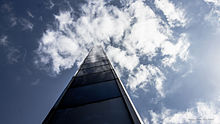
Gelsenkirchen was strongly influenced by the coal and steel industry ( Ruhr mining ) until the 1980s . Because this branch of industry no longer had a future and the mines in Gelsenkirchen closed one after the other, the city tried to position itself primarily as a center for solar technology at the end of the 1990s. The economic weakness is reflected, however, in an unemployment rate that was well above the national average of 5.8% , which was 11.9%. (as of October 2016).
In the future atlas 2016 , Gelsenkirchen was ranked 389 out of 402 regional authorities in Germany, making it one of the regions with “high future risks”. The city thus occupied the penultimate place among all districts and cities in West Germany and the last place among all independent cities in the entire federal territory.
Companies
- The Amro GmbH is a medium-sized global company for plant construction, installation and pipeline construction.
- August Friedberg GmbH is a screw manufacturer for the automotive industry, machine and steel construction and the wind power industry and employs 450 people (2014)
- The Bergmannsheil und Kinderklinik Buer emerged from the Knappschaftsklinik Bergmannsheil, which was founded in 1929 by the mining professional association and which merged with the municipal children's clinic in 2002.
- BP Gelsenkirchen / Ruhr Oel: Fuels and petrochemical products are produced at two refinery locations. In 2013 the company employed around 1980 people.
- BRIDON International at Magdeburger Str. 14 (117 employees), manufactured the longest steel cable in the world in 2007. It was four km long, 14 cm thick and weighed 370 tons.
- Courtyard-by- Marriott hotel on Kurt-Schumacher-Strasse with (2008) 90 employees.
- ELE ( Emscher Lippe Energie GmbH), regional energy supplier, sales of 485 million euros (2006).
- Eon Engineering , has 700 jobs in 2008 (mostly engineers).
- The Gelsenkirchen workshops for adapted work gGmbH offers over 600 jobs for people with disabilities, 800 employees.
- Gelsenwasser AG is Germany's largest water supplier and employs 1123 people at Willy-Brandt-Allee.
- GELSEN-NET is a communications service provider and city subsidiary at Horster Str. 119 and in 2009 employs a total of 180 people.
- GGW (Gelsenkirchener Gemeinnützige Wohnungsbaugesellschaft mbH), the housing company of the city of Gelsenkirchen
- Küppersbusch manufactures large kitchens in the Schalke industrial park and has 350 employees (2009).
- LOXX is a global forwarding company with 243 employees across Germany (2011).
- Lüttinghof-Verlag periodically publishes the magazines GE: spräch and GE: Kult.
- Masterflex was founded in 1987 and is a listed specialty plastics manufacturer for hose systems. The profit in 2012 was 4.4 million euros. It has 110 employees locally and 501 worldwide (2012).
- medicos.AufSchalke is an interdisciplinary competence center for outpatient rehabilitation, prevention and sport and employs 160 (2011) employees.
- Müller's Mühle belongs to VK Mühlen AG and has around 140 (2020) employees.
- Nienhaus & Lotz GmbH manufactures designer women's fashion. In 2009, 153 people were employed at Emscherstraße 20 and 789 worldwide.
- The Norres Hose Technology , on city port, was founded in 1889 and employed 2,013 national and 160 international 220 employees.
- The glass manufacturer Pilkington in Haydnstrasse took over Flachglas AG in 1980 (formerly DELOG Deutsche Libbey-Owens-Gesellschaft für mechanical glass production ), 500 employees (2020).
- Rexam is a can maker; In connection with the introduction of the can deposit, the number of employees was reduced to 110.
- REL ( Radio Emscher-Lippe ) is based in Gelsenkirchen-Buer , Hochstr. 68
- Roller , furniture store with over 80 discount stores. 160 employees work at the headquarters on Willy-Brandt-Allee.
- SABIC , a Saudi Arabian company, makes polyolefins. The Gelsenkirchen plant wastaken overby DSM in 1997; around 400 employees (2020).
- Siemens IT services and consulting (formerly SBI Ruhr), IT service provider (formerly RAG-Informatik)
- Schalker Eisenhütte Maschinenbau GmbH, coking machines and rail vehicles
- FC Schalke 04 , the club offers 300 jobs for permanent employees around the arena
- The Schülerhilfe is a franchise company in the tutoring industry. More than 100 permanent employees and around 10,000 tutors across Germany work at the company's headquarters in Gelsenkirchen.
- The St. Georg welfare organization operates residential homes for mentally and physically disabled people in North Rhine-Westphalia, employing 2200 people.
- Sparkasse Gelsenkirchen , local savings bank.
- The Stadtwerke Gelsenkirchen are the local public utilities
- St. Augustinus Gelsenkirchen GmbH , non-profit, has around 2100 employees and operates, among other things, two hospitals, an old people's home, a nursing home and youth home, kindergartens, cemeteries and residential and commercial buildings.
- Stölting Group has been a real estate service provider since 1899, in Erle, has around 900 employees in 2014 in the city and around 3500 in Germany and Austria.
- Straßen.NRW is part of the state administration of North Rhine-Westphalia. At the company's headquarters in Wildenbruchstr. 1 475 employees.
- Vivawest , formerly THS Wohnen , one of the strongest property management companies in Germany
- TRW Automotive , automotive supplier on Freiligrathstrasse, 570 employees (2020)
- The Verkehrsverbund Rhein-Ruhr has on Augustastr. 1 has its head office in the city center with around 160 employees.
- Uniper Anlageservice , at Bergmannsglückstrasse 41; has 400 employees in 2020.
- Uniper Kraftwerke GmbH (operator of power plants, including Scholven power plant , electricity generator).
- Voigt & Schweitzer , European group of companies in the field of surface finishing of steel, has its main plant in Gelsenkirchen-Schalke and another administrative headquarters in Gelsenkirchen-Buer.
- Volksbank Ruhr Mitte eG , local Volksbank with headquarters in the Buer district, Goldbergplatz 2–4.
- The Center for Ventilation and Intensive Care NRW GmbH provides clients with out-of-hospital ventilation and in a minimal state of consciousness
power
In 2016, Gelsenkirchen achieved a gross domestic product (GDP) of € 7.656 billion within the city limits and was 49th in the ranking of German cities by economic output . The nominal growth over the previous year was 1.8%. In the same year, GDP per capita was € 29,284 (North Rhine-Westphalia: € 37,416 / Germany € 38,180) and thus well below the regional and national average. On March 31, 2005 there were 70,969 employees subject to social security contributions in Gelsenkirchen, around two thirds of them in the service sector . Furthermore, there were around 108,000 people in gainful employment in Gelsenkirchen on June 30, 2005, including around 8,900 self-employed and 7,000 entrepreneurs. The unemployment rate was 12.1% in December 2018 and thus well above the average for North Rhine-Westphalia of 6.4%. The economy in Gelsenkirchen had a turnover of almost eight billion euros in the first half of 2005. This represents an increase of 16.4% over the same period in the previous year. The export turnover in the same period was around 610 million euros and represents an increase of 19.4% over the same period in the previous year.
According to a study by the Bertelsmann Foundation, the city of Gelsenkirchen is Germany's fourth most business-friendly city after Leipzig , Karlsruhe and Bremen in view of its infrastructure and local politics . In contradiction to this, however, there is a trade tax multiplier of 480% (2016), which is well above the national average.
The two largest shopping streets in Gelsenkirchen are Bahnhofstrasse , which leads directly to the main train station and the station center , to Neumarkt, and Hochstrasse in the Buer district, with Bahnhofstrasse, with around 55,000 daily pedestrians, being the most important shopping streets in the central Ruhr area and beyond is one of the 30 most visited shopping streets in Germany .
Economic development
Until the middle of the 19th century, Gelsenkirchen was mainly characterized by agriculture; the village had only a few hundred inhabitants.
Then in Gelsenkirchen, as in the rest of the region, the economic turnaround from agriculture to heavy industry began with the mining of hard coal in the Ruhr area . The development of industry required transport links; it gave the impetus for the construction of the main line of the Cologne-Mindener Eisenbahn-Gesellschaft . Attracted by the growing industry, more and more people, often from East Prussia , which today belongs to Poland and Russia , came to the Ruhr area to work there. By the turn of the 20th century, the number of Gelsenkirchen residents quadrupled to just under 150,000 within a few years.
Heavy industry has developed into the most important branch of industry in Gelsenkirchen over the years. After many jobs had been rationalized away in the 1920s, there was again a strong economic upswing in Gelsenkirchen in the 1930s, which made Gelsenkirchen Europe's number 1 hard coal location. The beginning of war production contributed to this upswing. Due to the great economic importance of Gelsenkirchen, more than three quarters of the city was destroyed in the Second World War .
Since the 1960s, the mining industry in Gelsenkirchen has also lost its former importance. With some hesitation and considerable structural problems, Gelsenkirchen embarked on new paths and tried to distinguish itself as a location for future technologies. On the one hand, Gelsenkirchen has made a name for itself as a solar city (among other things, the solar cells for the new Berlin main train station were produced in Gelsenkirchen), on the other hand there is a significantly expanded service sector.
traffic
Connection
Gelsenkirchen is located on the federal highways 2 , 40 , 42 and 52 as well as on the federal highways 224 , 226 and 227 . The city has 1,500 streets for a total length of 763.93 km (including highways).
The Gelsenkirchen Station is located near railroad tracks Duisburg-Oberhausen-Herne-Dortmund and Essen - Recklinghausen Minster . Regional and long-distance trains run on six tracks. There are five further stations of the SPNV in the districts of Rotthausen, Hassel, Buer, Beckhausen and Bismarck.
The city lies on the Rhine-Herne Canal , on which the port of Gelsenkirchen is located. As an industrial and commercial port, with an annual turnover of two million tons and a water surface of around 120 hectares, it is one of the largest and most important canal ports in Germany and is also connected to the rail network of DB Netz AG.
Bus and tram


Local transport in Gelsenkirchen is served by trams and buses of the Bochum-Gelsenkirchener Straßenbahn AG BOGESTRA as well as primarily in the north of the city by the Vestische Straßenbahnen (the company is called Vestische Straßenbahnen GmbH, but today it only operates buses). There are also at various city cross scheit compounds SB-lines of STOAG and BVR , added the city buses of the Ruhr railway , which also a tram route is traveling. All lines are integrated into the tariff of the Rhein-Ruhr transport association . There are three tram lines (107, 301, 302), a light rail line (U11, which - north of the canal above ground - connects the Horst district with Essen University , the city center there and the exhibition center ) and around 50 bus lines. In addition, there are several night bus routes on the weekend / before public holidays , which guarantee an hourly basic supply between 0:00 and 5:00, and there is also a (half-) hourly offer in DB local transport.
Subway
In Gelsenkirchen, individual tram or light rail lines run underground in sections. About 90% of the Gelsenkirchen subway tunnels are, due to their special construction, subsidence and earthquake-proof . The protection against subsidence was the sole reason for the newly developed construction method, which is primarily intended to prevent mining damage caused by not (properly) filled shafts of the predatory mining. The disadvantage of this type of construction, however, is the cost, which is about twice as high as that of a standard tunnel.
A line U21 was also planned for a longer period of time, which would run from Buer Nord station via Buer Mitte, Erle, Bismarck, Schalke, Gelsenkirchen Hauptbahnhof, Ückendorf to Witten. However, this plan was rejected. The 1998 state planning included the extension of line 302 to Buer Nord station. This has not yet been realized until today (January 2019). In addition, the then Essener Verkehrs-AG (EVAG) planned in the meantime to continue the U11 line to the arena, but this project was also not implemented for cost reasons.
Infrastructure expansion on the occasion of the 2006 World Cup
On the occasion of the 2006 soccer world championship , the transport infrastructure in Gelsenkirchen was expanded towards the Veltins-Arena . From the beginning of 2005, the Gelsenkirchen main train station was extensively rebuilt and completed on June 8, 2006, one day before the start of the 2006 World Cup. The German railway - Travel Center was placed much closer to the platforms, demolished the old travel center and built there a new station near the taxi stand. In addition, the subway exit and taxi stand were given a roof with a photovoltaic system. Furthermore, an elevator was built to each platform and a guidance system for the blind was laid so that the station is now barrier-free . The platforms in the underground station have been lowered and the power supply for line 302 has also been expanded so that it can now be used by two vehicles coupled to one another ( double traction ). The Veltins-Arena tram stop has been given the character of a train station thanks to a generous roofing, but it is not barrier-free; Wheelchair users are asked by an announcement in the tram to leave it at the neighboring Willy-Brandt-Allee stop.
The construction work in the immediate vicinity of the station and on the infrastructure to and from the arena will be supplemented by a redesign of the Gelsenkirchen shopping area - Bahnhofstrasse and the station center. Other major construction projects included the complete renovation of the Uferstraße (important east-west connection parallel to the Rhine-Herne Canal), the new junction of the A 42 with the designation Gelsenkirchen-Schalke and other construction measures, such as the extension of turning lanes.
Others
An Intercity-Express has been named after the city since September 7, 2004 . (see list of IC / ICE vehicles named by municipalities and regions # 134)
The planned Ruhr cycle route also runs through Gelsenkirchen.
From 1912 to around 1940 there was an airfield in the Feldmark district , and also largely for military purposes from around 1934 in Berger Feld . The Park Stadium was built on this area decades later.
media
The only remaining local daily newspaper is the Westdeutsche Allgemeine Zeitung (WAZ). On April 1, 2006, the Ruhr-Nachrichten stopped the local edition for Gelsenkirchen. The Buersche Zeitung was published for the last 125 years on September 30, 2006. Instead, the sister paper Hertener Allgemeine (local edition of the Recklinghäuser Zeitung ), which continues to appear, has a maximum of one page with Gelsenkirchen, primarily Buerian short reports, which are of no importance throughout the city. Gelsenkirchen is thus a one-newspaper group . Furthermore, the advertising paper Stadtspiegel Gelsenkirchen is distributed in the city area on Wednesdays and Saturdays, and Buer has its own edition of this.
Furthermore, the advertising printing units 100% Buer and BUER! and subsequently, published since November 2019 Hallo Buer , the latter on newsprint in tabloid format . In addition, the monthly or irregular issues of Familienpost , Beckhausener Kurier and Wochenblick for Gelsenkirchen appear. The Gelsenkirchen city magazine isso is free once a month . to have. The free monthly magazine GE: spräch was converted into the now paid Ruhr talk in 2016 . The magazine GE: kult , which provided information on current art and culture with local reference, was only published until 2012 . Since March 2013, the city administration has published the eight-page citizens' magazine GELSENKIRCHEN four times a year , which can also be viewed on the city's website.
Gelsenkirchen is the seat of the Association of Local Broadcasting in North Rhine-Westphalia, founded in 1987 . V. (VLR) , which represents the interests of the organizer communities in North Rhine-Westphalian local radio. In Gelsenkirchen-Buer, the radio station Radio Emscher-Lippe is located on Hochstraße .
The TV learning channel nrwision bundles TV programs about Gelsenkirchen or from TV makers from Gelsenkirchen in its media library.
The local historical website Gelsenkirchen Stories was launched in 2006.
education
The Westfälische Hochschule Gelsenkirchen Bocholt Recklinghausen was founded in 1992 as the Gelsenkirchen University of Applied Sciences and was given its current name in 2012. The university maintains the following departments: economics , commercial law , computer science , physical technology, electrical engineering , mechanical engineering , journalism & public relations, and supply and disposal technology. Gelsenkirchen is also one of seven locations of the University of Applied Sciences for Public Administration in North Rhine-Westphalia (departments: municipal administration service, police enforcement service, model course in administrative business administration).
In Gelsenkirchen there are 51 elementary schools (36 community elementary schools, twelve Catholic elementary schools, three Protestant elementary schools), eight secondary schools, six secondary schools, seven grammar schools (four near the old town, three in Buer; today's Schalker grammar school , founded in 1876, is the city's oldest ) and four comprehensive schools, of which the Evangelical Comprehensive School Gelsenkirchen-Bismarck is the only comprehensive school sponsored by the Westphalian regional church and also the only independent school in Gelsenkirchen. The comprehensive school Berger Feld is located in the immediate vicinity of the club area of the Bundesliga soccer club FC Schalke 04 , with which there is an intensive cooperation. The Gelsenkirchen Talent Center has existed since 1995 and the Auf Schalke football school / partial boarding school in Berger Feld since 2000. Of 53 users of this part of the boarding school, 23 have made the leap into the professional field, including Mesut Özil , Manuel Neuer , Alexander Baumjohann , Benedikt Höwedes , Sebastian Boenisch , Tim Hoogland , Michael Delura , Julian Draxler and Joel Matip . In June 2007, the Berger Feld comprehensive school was the fourth German school to be recognized by the DFB as an elite school for football . In addition, there are four vocational colleges: in the south the vocational college for technology and design (BTG) and the vocational college in Königstraße, in the north the Eduard Spranger vocational college and the Hans Schwier vocational college. In addition, there are 14 special schools in Gelsenkirchen for pupils with special needs ( special needs : learning, mental development, language, emotional and social development, hearing and communication, vision, physical and motor development, as well as a school for the sick).
In Sutum, the FloristPark International on Theodor-Otte-Straße on a former farm that is under monument protection is the only technical school in Germany run by the Fachverband Deutscher Floristen e. V. operated where regularly to the profession of florist masterclasses champion and advanced training courses for florists take place.
In Virchowstrasse in Gelsenkirchen-Ückendorf, Christian hospitals from Gelsenkirchen and the surrounding area maintain the ecclesiastical education center for health professions in the area for training in elderly care, nursing and child care .
The city administration of Gelsenkirchen operates an adult education center and a city library with three branches in the districts of Horst, Buer and Erle with more than 100,000 books, films and CDs. There is also a traveling book bus that stops on various streets in the city.
research
Gelsenkirchen is the location of many research institutions that deal with a wide variety of specialist areas. The Rheinelbe Science Park is a research center in the Ückendorf district. Among other things, solar technologies from various companies are being researched there; the Institute for Urban History researches the city's past and the Institute for Work and Technology researches new methods, techniques and technologies related to the world of work. The IKT Institute for Underground Infrastructure , which is also located in the Ückendorf district, develops innovative technologies for sewer systems.
Some other research institutions are the University of Applied Sciences for Public Administration in North Rhine-Westphalia (including the Institute for Administrative Sciences), the Hygiene Institute of the Ruhr Area, the Westphalian University (including research focus on component-based software development (CombaSoft), the Institute for Internet Security , the Institute for the Promotion of Innovation and Business start-up, Institute for Biological and Chemical Informatics, Institute for Demand Logistics), the laboratory and service center of the Fraunhofer Institute for Solar Energy Systems and the Pathological and Tissue Pathology Institute.
technical aid organization
An office and a local association of the Federal Agency for Technical Relief are located in Gelsenkirchen . The two technical trains consist of four rescue groups and the specialist groups for infrastructure, rooms and electrical supply. The accommodation is located in the civil protection center of the city of Gelsenkirchen, Adenauerallee 100.
Culture and sights
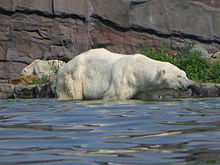
Special cultural institutions are the ZOOM Erlebniswelt (former Ruhr Zoo), the Rheinelbe Science Park , the Sport-Paradies, the Kaue (socio-cultural center) and the Die Flora cultural center . The permanent model railway exhibition was located on the former site of the Nordstern colliery ( Bundesgartenschau 97) ( http://www.waz.de/staedte/gelsenkirchen-buer/modelleisenbahn-im-nordsternpark-signale-haben-auf-rot-id12267825.html ) The Deutschlandexpress , until 2001 the largest digital three-rail model railway in the world; today only the Miniatur Wunderland in Hamburg and the Loxx Miniatur Welten Berlin are bigger.
There are also some settlements, viewpoints and anchor points on the Route of Industrial Culture in Gelsenkirchen . The Gelsenkirchen viewpoints on the route are the Rungenberg and Rheinelbe heaps . The settlements Flöz Dickebank and Schüngelberg were also included in the route . The Nordsternpark offers information about the former colliery area and the industrial past of the region. It is therefore called one of the anchor points of the route.
Due to the Budget Security Act, extensive austerity measures were taken in the field of culture.
theatre

There are several theaters with different focuses in Gelsenkirchen. The Musiktheater im Revier , MiR for short, houses two stages, the big and small house. The MiR program mainly consists of opera , operetta , musical , ballet , drama (guest performances) and children's and youth theater.
The Neue Philharmonie Westfalen , which also plays in the MiR, was created in 1996 from the merger of the orchestras from Recklinghausen and Gelsenkirchen and today it plays as one of three regional orchestras in all of North Rhine-Westphalia . Furthermore, the Europe-renowned Ballet Schindowski of Bernd Schindowski his permanent home in MiR.
Located in the North Star Park situated Amphitheater Gelsenkirchen was 1997 Bundesgartenschau built on the Rhine-Herne Canal. In spring and summer, the amphitheater hosts the rock-hard festival , various other music events and open-air cinema performances.
The Consol Theater in Bismarck was once the fan machine building with the ventilation machines from the Consolidation colliery . Since 2001 there have been regular performances in the Consol Theater with a focus on children's and youth theater.
The Emscher-Lippe-Theater is an ensemble of young artists from the Emscher-Lippe region around Gelsenkirchen. The performances take place in municipal schools in the region.
The theater company Preziosa 1883 e. V. is another ensemble that consists exclusively of amateurs and also uses municipal schools for its performances.
Furthermore, various music events with international artists and musicals take place at irregular intervals in the Veltins-Arena - up to now, for example, the operas Aida , Carmen and Turandot have been performed.
Museums
The Gelsenkirchen Art Museum is located in the center of the Buer district at Horster Strasse 5–7 . It was opened in 1984 after two years of construction. The collection includes around 1300 exhibits from classical modernism , constructivism , kinetics and contemporary art, a graphic collection and the collection of Anton Stankowski . Six to eight temporary exhibitions are held annually.
Museum Schloss Horst with video animations and technical effects. The theme is "Living and Working in the Renaissance". The opening was on November 4, 2010.
The small collection Der Treudank on Vattmannstrasse houses documents from the former German city of Allenstein (East Prussia).
There are also some private museums .
In the small museum in Eschweiler Str. 11, the history of mining in Gelsenkirchen and in particular the Hugo colliery is shown.
The Rotthausen Mining Collection , Belforter Str. 20, is also dedicated to this epoch of industrial history.
The motorcycle museum at Wallstrasse 52 has 90 vintage cars and was headed by Karl Rebuschat (* 1932; † June 4, 2012). The oldest machine is a DKW blood bladder from 1925. Attached is a parts market with rare items, which is open every second Sunday of the month and attracts thousands of motorcyclists.
The Schalke Museum in the southern Veltins Arena deals with the history of FC Schalke 04.
Libraries
- Gelsenkirchen City Library (with district libraries in Erle, Horst and Buer)
- Library of the Gelsenkirchen University of Applied Sciences
Galleries
- Atelier antenna
- Halfmannshof artists' settlement . It has existed since 1931 and has always housed only one artist of all six art movements. The big time was in the 1960s / 1970s when Ferdinand Spindel was her spokesman. Ever since Spindel discovered foam as an art design material, the city has been an avant-garde center, and Düsseldorf and Cologne art experts have traveled to Gelsenkirchen. The court organized important exhibitions such as Zero, Constructive and Light Art.
- Jazz & Art Gallery (Lutz Motzko)
- Gallery Kabuth
- Gallery stone
- Galerie Patricia Ferdinand- Ude (awarded the Banana by Thomas Baumgärtel )
- The workshop
- Gallery one hundred . Photographs from the collection of the pixel project Ruhrgebiet are exhibited and sold there . The name of the gallery is derived from the fact that the photographs are each produced in a limited edition of 100 + 1 pieces.
Buildings
According to the Lower Monument Authority of the City of Gelsenkirchen, there are 343 architectural monuments in the city.
Churches
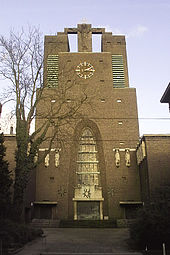
- The Evangelical Old Town Church stands on the site of the old village church of St. Georg (founded around 1000) and the historicist predecessor church from 1884, which was destroyed in the war. Today's building, the main work of the Gelsenkirchen architect Denis Boniver , was inaugurated in 1956 and shapes the cityscape with its striking tower.
- The Catholic Propsteikirche St. Augustinus am Neumarkt is a neo-Gothic basilica that was consecrated in 1892.
- In the center of Buer is the neo-Gothic provost church of St. Urbanus , which was completed in 1893. Its silhouette is shaped by the blunt tower (since World War II).
- The neo-Gothic Horster Hippolytus Church (1897) is best known for its modern stained glass windows.
- Several notable churches from the period between the world wars have been preserved, including the listed Holy Cross Church by Josef Franke on Bochumer Straße.
- The Catholic Church of St. Mary of the Assumption , built from 1891 to 1897, rises on Richard-Wagner-Strasse . The church, built by the Paderborn diocesan master builder Arnold Güldenpfennig , is one of the rare three-tower churches in the diocese. It contains high quality, artistically designed interior. The west tower is richly structured and forms a counterpoint to the two smaller east towers. Although it has been under monument protection since 1994 and has no relevant structural damage, it was released from church services on June 7, 2007 as part of the austerity measures of the diocese of Essen.
- The first Evangelical Paulus Church in Gelsenkirchen-Bulmke, built between 1910 and 1911, was the work of the church builder Arno Eugen Fritsche . On October 9, 1910, the foundation stone for the new building was ceremoniously laid, and it was inaugurated on December 15, 1911.
Then came November 6th, 1944. During the large-scale attack that reduced large parts of Bulmke to rubble and ashes, an explosive bomb hit the burned-out church. As a result, the main portal side and the east side of the church collapsed.
The revitalization of the church building association in 1952 was the starting signal to try something new. Several architects made plans to rebuild the Pauluskirche. In the end, Otto Prinz prevailed with his designs. Reconstruction turned out to be more difficult than hoped. Nevertheless, on June 23, 1957 the time had come when the new church was consecrated.
To this day it has remained almost unchanged. In its outer shape, no longer the monumental building from 1911, but paying respect to the simplicity of the 1950s, it rises on its hill in the middle of the Gelsenkirchen-Bulmke district.
Hans Sachs House
A characteristic building in downtown Gelsenkirchen is the Hans-Sachs-Haus, an office and commercial building with a concert hall built in 1927 by the Essen architect Alfred Fischer . Its rounded corners and an expressionist tower are particular stylistic features . Stylistically, the house represents a link between brick expressionism and the new, factual architecture of the Bauhaus style. The Hans-Sachs-Haus served as the town hall for decades and housed the largest secular hall organ in Europe, a Walcker organ with 92 stops in the concert hall . What is believed to be the world's first color coding system was in the hallways of the house .
The plan to renovate the partially dilapidated Hans-Sachs-Haus (according to the expert report) in accordance with a listed building failed due to unfavorably concluded contracts and the desolate financial situation of the city of Gelsenkirchen. A cost explosion prevented the reopening, which was originally planned for 2007, and instead a long construction freeze followed. Finally, an architectural competition was held to look for ways to preserve and revitalize the house. The winner of the competition was the architects Gerkan, Marg und Partner , whose design provided for the gutting of the historic Hans Sachs House and a new building while preserving the brick facade and the tower. After the interior construction phase, the subsequent handover took place in August 2013. Since then, the Hans-Sachs-Haus has again been the seat of the city administration and mayor.
Musical theater
The music theater in the Revier , built between 1956 and 1959 by Werner Ruhnau , Harald Deilmann , Ortwin Rave and Max von Hausen , is one of the most important structures of German post-war architecture and offers space for 1005 visitors. The MiR on Florastraße exudes a special flair, especially at night . In the foyer of the MiR there are large blue sponge reliefs by the French artist Yves Klein . The adjoining Small House (for 347 visitors) houses an early kinetic work by Jean Tinguely .
Brick expressionism
The architect Josef Franke shaped the cityscape of Gelsenkirchen in the 1920s with several representative buildings that are attributed to brick expressionism. These include the Ricarda-Huch-Gymnasium (formerly Lyzeum Aloysianum ), the Ring-Eck residential and commercial building , the tram depot on Wanner Strasse and the Heilig-Kreuz-Kirche (Bochumer Strasse 115) in Ückendorf, a parabolic Catholic church from 1927 to 1929. A 41 m high tower was built over three portals, which connects two bell towers in the middle. At the very top, a brick figure of Christ was built. In 1993, the church received the award Europa Nostra and stands since the 1990s under monument protection . It was closed as a church in 2008 and serves as an exhibition building.
Further examples of the brick Expressionism widespread in Gelsenkirchen are the former tax office south built in 1928 , the Volkshaus Rotthausen built in 1920 and the Hans-Sachs-Haus (see above). To the west of the tax office at Zeppelinallee 15, the client Hohen-Hinnebusch built an apartment building in the 1930s. He had the man with empty sandstone pockets built into the facade above . The figure still points to the former tax office without being contradicted.
Sports architecture
The best-known and largest building in Gelsenkirchen is the Veltins-Arena (former Arena Auf Schalke ), built in 2001 in the Erle district ; it has a retractable lawn and a closable roof. The home ground of FC Schalke 04 offers 62,271 guests for national football matches, while there are only 54,740 seats in the arena for international matches due to the standing room ban. For concerts, the arena even has a capacity of 79,612 spectators. The stadium, which was initially classified as an elite stadium in accordance with the UEFA stadium infrastructure regulations and has been classified in classification 4 since 2010, can be seen from many, even distant points in the Ruhr area.
Its predecessor - the Parkstadion - is located in the immediate vicinity of the Veltins Arena . It was opened in 1973 as the successor to the Glückauf-Kampfbahn , which was, however, still in the Hessler district (today in the Schalke-Nord district), and one year later it was a venue for the 1974 World Cup . After the stand was demolished, a hotel and a rehabilitation center were built there for the 2006 FIFA World Cup .
The grandstand of the GelsenTrabPark , built in 1965 and expanded in 1979, was the largest closed grandstand in Europe when it opened. The grandstand is 112 meters long and has 9,600 seats.
Industrial buildings and monuments
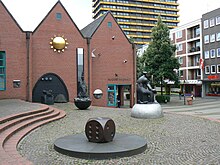

From the end of the 19th century to the middle of the 20th century, Gelsenkirchen was one of the largest cities with a predominantly mining economy. Many industrial plants of the coal and steel industry have been preserved from this time . Some of the facilities have been restored and, for the most part, converted.
Some prime examples of the conversion of old colliery facilities are the shaft hall of the Nordstern colliery , which today after extensive restoration is home to the headquarters of THS GmbH , the machine hall of the Oberschuir shaft of the former Consolidation colliery in the Feldmark district is a regular place for exhibitions of all kinds that have been restored Mining settlement Schüngelberg in Buer an der Halde Rungenberg or the Consol-Theater, which is located in the fan machine building of the Consolidation colliery.
- Double Malakoff system from Zeche Holland 1/2
- Headframe of the Consolidation colliery in Bismarck, the last half-timbered double frame in Westphalia
- Headframe, headframe and head of the Nordstern colliery in the Nordsternpark
- Headframe with machine hall of the Hugo colliery in Buer
- Formerly Prussian colliery Bergmannsglück on Bergmannsglückstrasse north of Buer
- dotted gas pressure vessel on Üchtingstrasse / Emscher; designed by Rolf Glasmeier
- Former station keeper's house on Horster Strasse with the inscription "Hugo Bahn". It has been standing since 1880, is an industrial monument and in the best condition.
- The Bismarck depot from 1924 is a listed building. It has a roundhouse with a turntable and is located on Grimbergstrasse.
More buildings

On an extensive industrial site in Ückendorf, coal was mined in the Rheinelbe colliery from 1861 to 1930 , after which the cast steelworks was in operation until 1984. In 1989, planning began here for the Rheinelbe Science Park , which was built in 1995 for the IBA Emscher Park . He was awarded the German Architecture Prize. The 300 m long hall with its inclined glass facade is at right angles to the connected office wings. In the glass hall there is a work by the light artist Dan Flavin ; it offers space for changing exhibitions. The building carries one of the largest roof photovoltaic systems . The Institute for Underground Infrastructure , which is also located in the Ückendorf district, is similarly futuristic as the Science Park.
The moated castle Haus Lüttinghof was built in 1308 on the initiative of the Archbishops of Cologne to protect the Recklinghausen Castle. The name of the moated castle can be traced back to the Luttekenhove family, who received it as a fief. The art-historical rank of the castle is based on its medieval silhouette as a low castle. House Lüttinghof, which was extensively restored from 1988 to 1991, is located in a nature reserve in the north of Gelsenkirchen, at Lüttinghofallee 3.
Horst Castle is an important Renaissance castle in north-west Germany . During excavations at the castle in 2005, foundations from around 1200 were found. At least as long as the district of Horst is populated. The first building was erected as early as 1282, but the palace, which today serves as a registry office after restoration, was built in the early Renaissance from 1556 to 1578. In addition to the restored parts, a large glass hall was also built that spans the courtyard of the palace.
The Berge Castle , formerly also called Haus Berge , is in the Buer district on the south side of the Buerchen Berg . It was built as a moated castle to protect today's Gelsenkirchen district of Erle, but was converted into a palace in the first half of the 16th century in the late Baroque style.
The head office of Gelsenwasser AG is located on Kurt-Schumacher-Strasse at the corner of Willy-Brandt-Allee. The new building was occupied in 2004 and is a glass cube measuring 55 × 15 × 30 m³. The surrounding 40 cm deep water basin prevents a separate entrance. The new building by the architects Anin & Partner can only be reached via three bridges from the old building.
The WEKA-Karree in the city center was built in 1912 by the Düsseldorf architects Walter Klose and Georg Schäfer as a shopping center for the department store company Gebr. Alsberg AG . Today the WEKA-Karree is home to a branch of the VRR , the blood donation center Gelsenkirchen and various retail stores.
The Scholven power plant with an installed capacity of 2,300 megawatts, one of the most powerful coal-fired power plants in Europe. The 302 m high chimneys, which are among the highest in Germany, together with the seven cooling towers form an impressive industrial backdrop. From 1981 to 2003, a 160 megawatt thermal power station, the Westerholt power station , was operated in Gelsenkirchen-Hassel . Its chimney was 337 meters high, the fourth highest chimney in Europe and the highest in Germany. After the shutdown in 2003, the power plant was dismantled and the chimney was blown up on December 3, 2006.
On February 1, 2007, a new synagogue was opened on Gildenstrasse on the site of the old one, which was burned down in 1938 during the night of the Reichspogrom. The construction costs of 5.2 million euros were each borne by the state of North Rhine-Westphalia , the city of Gelsenkirchen and the Jewish community .
The amphitheater on the Rhine-Herne Canal in the Nordsternpark was built in 1997 on the occasion of the Federal Garden Show. The stage of the amphitheater is located in an indentation in the Rhine-Herne Canal that was specially excavated for the amphitheater. Since the end of the Federal Horticultural Show in 1997, it has repeatedly been used for open-air events such as concerts, cinema screenings and the annual rock-hard festival .
The market hall, built in 1998 in the Buer district, not only houses market stalls on 2000 square meters, but also a wide range of restaurants. The market hall was modeled on the style of old halls and passages.
Other structures:
- Office building or town hall Buer (built 1911) → Buer .
- Former seat of the Gelsenkirchen-Buer District Court (built 1973), Goldbergstrasse 89, a 6-storey building made of steel and glass. While the court was in existence, in front of the service building there was a mobile sculpture consisting of movable steel cylinders without a title by the Gelsenkirchen sculptor Günter Tollmann . With the move in January 2016, this sculpture was moved in front of the new justice center in the south of Gelsenkirchen.
- Former seat of the district court Gelsenkirchen-Buer , Overwegstraße, Gelsenkirchen, typical building from the time around 1900, but changed after war damage
- The rededicated Bleckkirche (today the municipal cultural site) in Bismarck was the oldest church in the city.
- Former manor house Leythe in Gelsenkirchen-Erle
- Indoor swimming pools in Horst, Buer, Schalke and Erle (sports paradise)
- Buer police station (built 1926)
- Justice center on the corner of Bochumer Strasse and Junkerweg
Parks

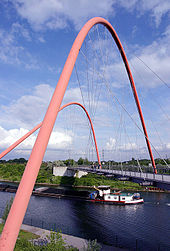
In addition to smaller forests, such as the Buerschen Stadtwald in the Buer district, Gelsenkirchen also has some parks. The Nordsternpark in Gelsenkirchen-Horst north of the Rhine-Herne Canal and its continuation, the Landscape Park Heßler , which is located south of the canal in the Heßler district, were the exhibition grounds of the Federal Horticultural Show in 1997 and are not least because of the large playground, the Germany Express of the climbing garden and of Hercules of Gelsenkirchen a popular weekend excursion destination. Many annual events such as the summer festival or the mineral exchange in the forum take place in the Nienhausen Revierpark to the south-west . The Revierpark also houses a mini golf course, an outdoor pool , several playgrounds, the activarium (thermal bath) and other facilities.
In the center of Gelsenkirchen is the 22 hectare city garden, which was created in 1897 under the name Kaiser Wilhelm Park . This includes a large duck and swan pond as well as extensive meadows. The approximately six hectare Bulmker Park in the Bulmke-Hüllen district, which is also relatively close to the city center , impresses with its simplicity. There is only one lake with a footpath around it. In the period after the Second World War, it was considered the largest black market in the Ruhr area.
Halfway between the Veltins-Arena and the city center of Buerer is the park Schloss Berge . In the castle park, the central point of which is a large lake, a large summer festival takes place every year, which in 2003 attracted more than half a million visitors. The Gelsenkirchen-Buer memorial is located north of the Berger See .
The Hoheward Landscape Park , the Von Wedelstaedt Park and the Rheinelbe Sculpture Forest should also be mentioned. In total, about a third of the area of Gelsenkirchen (that is about 35 km²) is green.
Sports
The most famous sports club from Gelsenkirchen is FC Schalke 04 (full name since 1928: FC Gelsenkirchen-Schalke 04 ), whose venue is the Veltins-Arena (former Arena AufSchalke ), which is also known for many concerts, musicals, operas and other events .
Ice hockey is played in the Emscher-Lippe-Halle in the sports paradise of Gelsenkirchen . The most successful club was the ESV Schalker Haie , which played second class in the mid-1980s. The current successor club, the EHC Gelsenkirchen , is exclusively dedicated to the youth and plays with its youth teams in the lower leagues of the LEV-NRW.
There are also several basketball clubs in Gelsenkirchen , such as Citybasket Gelsenkirchen , CSG Bulmke and the basketball department of FC Schalke 04 . FC Schalke 04 is the highest-ranking club in the 2nd Bundesliga Pro A and even played in the basketball Bundesliga in the 1988/89 season . There are also three badminton clubs in Gelsenkirchen .
The boxing club BC Erle 49 was represented in the first German boxing league from 1979 to 1991 and has also produced over 40 German champions in singles since 1954.
In Gelsenkirchen there is at least one municipal sports facility in every district with an ash or grass football field and a running track. A soccer club usually belongs to each of these sports fields . The most famous after FC Schalke 04 was STV Horst-Emscher , which was dissolved in 2007 , and SC Buer-Hassel 1919 , SSV Buer , SuS Beckhausen 05 , SpVgg Erle 1919 , RWW Bismarck 1925 e. V. and the ETuS Gelsenkirchen 34 . Overall, Gelsenkirchen has around 70 football clubs with around 10,000 members.
Gelsenkirchen also has a trotting track in the Feldmark district in the immediate vicinity of the Revierpark Nienhausen ( GelsenTrabPark ). Trotting races often take place here on Sundays from 1:30 p.m. or Thursdays from 6:30 p.m. (in exceptional cases on Fridays). In Gelsenkirchen there was a racecourse in the Horst district, but it was closed a few years ago. A 9-hole golf course is located in the middle of the former racecourse.
There is also a greyhound race track on Wiedehopfstrasse. in the Resser Mark district, not far from the city limits of Herne.
There are also outdoor pools in Heßler (Jahnstadion), the sports paradise in Erle, where only three indoor pools are available in winter, and in the Nienhausen district (Feldmark). In addition to these outdoor pools, there are indoor pools in the center (Zentralbad), in Horst, in Erle ( sports paradise ; also includes bowling alleys and shooting ranges) and in Buer .
The association TTC Horst Emscher was in the late 1980s with a women's team in the second Table Tennis Bundesliga represented.
Gelsenkirchen also has an American football club. The Gelsenkirchen Devils were founded in 1992 and currently play in the Regionalliga NRW.
Gelsenkirchen also has 25 local rifle clubs. The oldest, the Buer rifle club, was founded in 1769 and the youngest, the Sutum community rifle club, was founded in 2001. While 15 of these 25 clubs still maintain the old tradition of shooting, the other ten clubs are exclusively dedicated to shooting sports . The best known shooting club is the air rifle Bundesliga club BSV Buer-Bülse 1926 e. V.
Since 1966, the German three-cushion championship has been held a total of five times in Gelsenkirchen.
Regular events
There are many events in Gelsenkirchen, especially in spring and summer. In 2003 the summer festival at Schloss Berge attracted more than 500,000 visitors with its music program and not least with the annual fireworks display . The summer festival in the Revierpark Nienhausen (Feldmark district) also has tens of thousands of visitors every year and offers a varied live program, play facilities for children and fireworks. The Schlossparkfest at Schloss Horst, the Buersche Cityfest and Buer Live should also be mentioned.
In addition to the festivals, there are many sporting events, such as the Karstadt- Ruhrmarathon , whose come-together point (the point at which the two marathon routes came together) was in Gelsenkirchen in 2005. The Ruhr Olympiad , another regional sporting event in the Ruhr area, is also very popular with participants and spectators every year. Other sporting events include the Emscher Night triathlon in the Nordsternpark , the Buersche Radnacht and the biathlon in the Veltins Arena, for which several dozen tons of snow are brought in from the Bottrop Alpine Center, among others .
The Gelsenkirchen Jazz Days are known nationwide . Other musical events include the Buersche Musiknacht , which takes place several times a year, and the Gespaña , an annual Spanish cultural festival. In 2003 the metal magazine Rock Hard organized a rock festival in the amphitheater with top-class headliners like Blind Guardian on the occasion of its 20th anniversary at Whitsun . Due to its great success, the rock-hard festival was repeated the next year and has since become a national event in hard rock and metal .
Since 2008, the bild. Sprachen - platform for photography and photography projects has been taking place annually on two days at the Gelsenkirchen Science Park, with a national to international focus. In terms of content, the focus is on photography at the interface between commercial photography (design), documentary photography and art. The platform offers photographers the opportunity to present their projects, their ideas, their services, their style and their visual language to representatives of institutions and companies, as well as the media and the communications industry.
nightlife
The best-visited nightclub in town is the Alte Hütte in the Resse district , which celebrated its 30th anniversary in January 2013. The Apfelbaum discotheque on Willy-Brandt-Allee closed in July 2008 and reopened in October under the name Mad-House , but has been closed again since summer 2011.
The Kaue , which is located in parts of the building of the former Wilhelmine Victoria colliery in Gelsenkirchen Heßler, regularly hosts cabaret, concerts and other events. In the Gelsenkirchen old town there are several pubs and bars that offer a nightlife in Gelsenkirchen with parties and special events. The Irish Pub Consilium , Bang Bang Burger & Beer and Rosi tend to appeal to younger audiences. There is also the Flash Light, which is reminiscent of the old Gelsenkirchen disco Flash , and the City Pub Musiktreff. Irregular parties in the Gelsenkirchen city area are organized by an association which, under the name Bang Bang Gelsen, offers everything from hip-hop to house.
Furthermore, there is the in-inspired Baroque -Moods designed Amadeus in the old slaughterhouse, and which are also known, in the district Buer nearby pubs Zutz and Fliegenpils who occasionally engage DJs for discos, as well as the local no name , which in Gelsenkirchen also Fuck ( due to the graffiti that was never removed from the front of the house). Cocktail bars such as B. the Manyos are established in Buer. In 2007, 25,000 people willing to dance celebrated Germany's largest over-30s party in the Veltins-Arena.
Film location Gelsenkirchen

Scenes were shot in Gelsenkirchen for the following cinema, short and television films:
-
Comradeship , 1931
- Director: Georg Wilhelm Pabst , actors: Fritz Kampers , Alexander Granach , Ernst Busch and others
- The film was shot underground in Gelsenkirchen mines .
-
The miracle of Malachias , 1961,
- Director: Bernhard Wicki , actors: Horst Bollmann , Günter Pfitzmann , Günter Strack , Loriot and others
- The film was shot at the Protestant old town church and in the music theater in the Revier .
-
The tenderness of wolves , 1973
- Director: Ulli Lommel , actors: Kurt Raab , Wolfgang Schenck , Rainer Werner Fassbinder , Tana Schanzara , Rosel Zech , Brigitte Mira and others
- The film was shot at the old Gelsenkirchen main train station , among other places .
-
Alice in the Cities , 1974
- Director: Wim Wenders , actors: Rüdiger Vogler , Yella Rottländer and others
- The scene at the grandmother's house was filmed on Kanalstrasse in Gelsenkirchen-Bismarck.
-
The end of domination , 1976
- Direction: Gabi Kubach , actors: Gila von Weitershausen , Manfred Zapatka , Pola Kinski and others
- Both the old station forecourt and the interior of the old main station can be seen as the scene of a longer scene.
-
Tour de Ruhr , 1980
- Actors: Marie-Luise Marjan , Ralf Richter and others
- The shooting took place at Hochkampstrasse / Ruhrzoo / Parallelstrasse, among others
-
Conflagration , 1980
- The shooting took place mainly in Rudelgasse (Erle) and on De-la-Chevallerie-Straße in the area of the town hall.
-
Crime scene , episode shot , 1980
- Actors: including Willy Semmelrogge
- The film was shot on May 14, 1980 on Feldhauser Straße / exit to B 224 towards Essen.
-
Johnny Flash , 1986
- Director: Werner Nekes , actors: Helge Schneider , Andreas Kunze , Heike-Melba Fendel and others
- The film was shot on the trotting track in Gelsenkirchen at Nienhausen-Busch (Gelsentrab-Park).
-
The locomotive , 1991
- Director: Gerd Haag , actors: Rolf Hoppe , Marcus Fleischer , Katharina Schüttler , Isabel Dotzauer , Christian Kitsch , Sebastian Kroehnert ,
- The film was shot on the site of the historic Gelsenkirchen-Bismarck depot .
-
Little Sharks , 1992
- Direction: Sönke Wortmann , actors: Jürgen Vogel , Kai Wiesinger , Gedeon Burkhard , Armin Rohde , Meret Becker and others
-
00 Schneider - The Hunt for Nihil Baxter , 1994
- Director: Helge Schneider, actors: Helge Schneider, Helmut Körschgen , Andreas Kunze and others
- The film was shot on Kesselstrasse in Gelsenkirchen-Bulmke.
-
Football is our life , 2000
- Director: Tomy Wigand , actors: Uwe Ochsenknecht , Ralf Richter, Oscar Ortega Sánchez , Tana Schanzara and others
-
Solino , 2002
- Director: Fatih Akin , actors: Christian Tasche , Moritz Bleibtreu and others
- A small part of this film, set in Duisburg , was shot in the Schauburg in Gelsenkirchen-Buer.
-
Two weeks in Argentina , 2002
- Director: Holger Haase , actors: Michael Kessler , Uli Krohn , Soraya Gomaa , Annabelle Herrmann and others
- The film was shot in Erdbrüggenstrasse on the premises of the Consolidation colliery in Bismarck.
-
Three women, one plan and the big money , 2002
- Director: Reinhard Schwabenitzky , actors: Tina Ruland , Marco Rima , Elfi Eschke , Meral Perin and others
- The film was shot on the Berliner Brücke, in the trade street and in the old Schüngelberg settlement near the Hugo colliery .
-
From the depths of space (Subtitle:… in the middle of the net! Groteske, 2004)
- Direction: Gil Mehmert, actors: Christoph Maria Herbst , Eckhard Preuß , Sandra S. Leonhard , Arndt Schwering-Sohnrey , Mira Bartuschek and others
- The film was shot on Bochumer Strasse in Gelsenkirchen-Ückendorf , among other places , which was transformed into a scene from 1965 with vintage cars and an old tram.
-
The Prince of Wanne-Eickel (Funny Ruhr area crime thriller, 2005/06)
- Direction: Alexander von Janitzky , actors among others: Anil Desai , Tim Dickmann , Mario Scheller , Hendrik Michaelis , Sabrina Lange , Alois Bröder , Detlef Zwitzers , Volker Schaper , Harry Wijnvoord , Roberto Blanco , Jürgen Drews .
- The film was shot at and in the Venetian discotheque, on a Gelsenkirchen golf course and on Lake Berger.
-
Melancholy , 2007
- Director: Christoph Nagel, actors among others: Philipp Heise, Lukas Piofczyk, Martha Zaremba, Tobias Sporkmann.
- Shooting took place at the Maritim Hotel, in the Stadtgarten, on the Rheinelbe slag heap and at the bus station in Gelsenkirchen-Buer.
-
The Abyss: A City Collapses (Disaster Film, 2008)
- Direction: Sebastian Vigg , actors: Liane Forestieri , Marco Girnth , Michael Lott , Ercan Durmaz , Oliver Stritzel , Christian Grashof , Henning Baum
- Among other things, it was shot at the administrative court (Alte Post), which in the film depicts a hospital in danger of collapsing due to a break in days; at the extrablatt café, where windows and furniture break in a quake (in the background Hamburg-Mannheimer building and Bahnhofstrasse); on the Ringstrasse (fire service to the extra sheet) etc .; all fire engines are from the Gelsenkirchen fire department , which accompanied the shooting in Gelsenkirchen. At the end of the film, the city coat of arms and the logo of the city of Gelsenkirchen can be clearly seen on the door of the fire engine.
-
El Olivo - The Olive Tree (tragic comedy, 2016)
- Direction: Icíar Bollaín , actors: Anna Castillo , Javier Gutiérrez , Manuel Cucala
- The film was shot in the Hans-Sachs-Haus , where the (artificial) olive tree was set up in the foyer, and on Alfred-Fischer-Platz at the rear of this building. In the film, however, it is associated that it is in Düsseldorf.
-
The Boy Needs Fresh Air - My Childhood and I (Autobiography, 2017)
- Director: Caroline Link , actor: Hape Kerkeling
- The film was shot at Ahlmannshof in the Bismarck district .
-
Gundermann (music film, 2018)
- Direction: Andreas Dresen , actors: Alexander Scheer , Eva Weißenborn , Axel Prahl
- Individual scenes were shot in Hassel .
Personalities
Others
- Mechtenberg nature reserve
- Mining Authority (closed since autumn 2010)
- District archive Rotthausen e. V. in the Volkshaus , Mozartstrasse 9, 45884 Gelsenkirchen
- Animal shelter in alder; In 2005 there were 11,000 dogs in Gelsenkirchen.
- By Georg Kreisler the song comes "That there is only here in Gelsenkirchen", which has also contributed to the fame of the city.
See also
literature
- Westphalian city book. Vol. III 2nd part of the German city book. Urban History Handbook. On behalf of the Working Group of the Historical Commissions and with the support of the German Association of Cities, the Association of German Cities and the German Association of Municipalities, ed. by Erich Keyser. Kohlhammer, Stuttgart 1954.
- Ground plan for German administrative history 1815–1945. Edited by Walther Hubatsch. Vol. 8. Westphalia. Johann Gottfried Herder Institute, Marburg an der Lahn 1980, ISBN 3-87969-123-1 .
- Jürgen Boebers-Süßmann: 125 years of Gelsenkirchen city history. Bookstore Minerva, Gelsenkirchen 2001, ISBN 3-921052-82-3 .
- Ludger Tewes : Middle Ages in the Ruhr Area. Settlement on the Westphalian Hellweg between Essen and Dortmund (13th to 16th centuries) . Schoeningh, Paderborn 1997, ISBN 3-506-79152-4 .
- Heinz-Jürgen Priamus (Ed.): Gelsenkirchen as it used to be. Wartberg, Gudensberg-Gleichen 1994, 1996, ISBN 3-86134-185-9 .
- Rolf Cadenbach: Our city of Gelsenkirchen. Workbook for the subject teaching of the elementary school . Aschendorff, Münster 1991, ISBN 3-402-02765-8 .
- Hans-Werner Wehling: Gelsenkirchen. Urban development, structural change and future prospects . Aschendorff, Münster 2014, ISBN 978-3-402-14940-9 .
- Statistical Atlas 2004, Gelsenkirchen
Web links
- Link catalog on Gelsenkirchen at curlie.org (formerly DMOZ )
- City of Gelsenkirchen - (Official website)
- GELSENKIRCHEN - (online edition of the city newspaper)
- ISG - Institute for Urban History
- Gelsenkirchen stories - Online forum about Gelsenkirchen
- Gelsenkirchen Stories Wiki - reference work about Gelsenkirchen
- Gelsenzentrum - portal for the processing and documentation of local historical events in Gelsenkirchen
- Gelsenkirchen in the Westphalia Culture Atlas
- City wiki Gelsenkirchen
- Literature from and about Gelsenkirchen in the catalog of the German National Library
- Chronicle Buer. The history of the city in 20 episodes . (WAZ)
Individual evidence
- ↑ Population of the municipalities of North Rhine-Westphalia on December 31, 2019 - update of the population based on the census of May 9, 2011. State Office for Information and Technology North Rhine-Westphalia (IT.NRW), accessed on June 17, 2020 . ( Help on this )
- ^ Gelsenkirchen belongs to an island in Bochum , Westdeutsche Allgemeine Zeitung from January 27, 2013
- ^ Finding aid inventory Amt Horst ( Memento from April 9, 2014 in the Internet Archive ), Institute for City History (PDF; 440 kB)
- ↑ Topographical Information Management, Cologne District Government, Department GEObasis NRW ( Notes )
- ↑ Population map Gelsenkirchen ( Memento of the original from February 22, 2014 in the Internet Archive ) Info: The archive link was automatically inserted and not yet checked. Please check the original and archive link according to the instructions and then remove this notice. with boundaries of city districts, city districts and statistical districts ("central block") together with the population of the latter (PDF; 5 MB)
- ^ German weather service: Climate information Gelsenkirchen. wetterdienst.de, accessed on April 19, 2020 .
- ^ Ralf-Peter Fuchs: witch hunt on Ruhr and Lippe. The use of justice by masters and subjects . Westphalian Institute for Regional History. Regional Association of Westphalia-Lippe. Muenster. Forum Regionalgeschichte 8. Ed. By Bernd Walter. Ardey Verlag Münster 2004, p. 40ff. Marlies Mrotzek: Anna Spiekermann (around 1670 - 1706) - the last victim of the witch hunt in Vest Recklinghausen , in: City of Gelsenkirchen (Ed.): Von Hexen, Engeln und other fighters , Gelsenkirchen 2001, pp. 75–79.
- ↑ H.Allekotte: Two witch trials in Horst . Horster Heimatbuch, ed. On behalf of the Heimatbund v. OstD. Gelsenkirchen in old and new times. Vol. VIII, pp. 51-57. Detmer, Ursel: witch trials in Horst . City of Gelsenkirchen (ed.): No story without women , Gelsenkirchen 1992.
- ↑ In 2004, on the occasion of its 100th anniversary, this association published a study in which the association's history in the times of the "Third Reich" was examined.
- ↑ http://www.gelsenzentrum.de/totenfeier_kirdorf_gelsenkirchen.htm
- ↑ http://www.gelsenzentrum.de/gelsenberg_lager.htm
- ^ The year 1945. Gelsenkirchen , accessed on: May 20, 2018
- ^ Institute for City History Gelsenkirchen
- ↑ Heimatabend - The Gelsenkirchen journey through time
- ^ City of Gelsenkirchen Religion , 2011 census
- ↑ Gelsenkirchen City Profile City Facts Statistics , accessed on July 13, 2020
- ↑ Figures from the Diocese of Essen , accessed on August 23, 2017.
- ↑ More Evangelicals in the north of the city ( Memento from August 24, 2017 in the Internet Archive ), November 12, 2013, accessed on August 23, 2017.
- ↑ Gelsenkirchen
- ↑ 2nd Gelsenkirchen Integration Conference on August 31, 2006 , accessed on October 2, 2012
- ^ Mosques in Gelsenkirchen
- ↑ Stephanie Reekers: The regional development of the districts and communities of Westphalia 1817-1967 . Aschendorff, Münster Westfalen 1977, ISBN 3-402-05875-8 , p. 235 f .
- ↑ Simon Michaelis: Broker in the Ruhr area. spiegel.de, September 1, 2015, accessed on September 1, 2015.
- ↑ Share of foreigners in Gelsenkirchen as of December 31, 2019 - Data source: City of Gelsenkirchen - opendata.gelsenkirchen.de
- ↑ Population by age and migration. Districts annually - data source: City of Gelsenkirchen - opendata.gelsenkirchen.de
- ↑ Debt ranking of the 103 independent cities in Germany . Household Control.de. Retrieved September 19, 2014.
- ↑ Sister cities on gelsenkirchen.de , accessed on May 23, 2020
- ^ Kaolack - the forgotten twin town
- ↑ An overview of the labor market - reporting month October 2016 - Gelsenkirchen, Employment Agency , accessed on November 4, 2016
- ↑ Future Atlas 2016. (No longer available online.) Archived from the original on October 2, 2017 ; accessed on March 23, 2018 .
- ↑ jobs. BP Gelsenkirchen, accessed February 23, 2013 .
- ↑ Manufacturer's website Bridon ( page no longer available , search in web archives ) Info: The link was automatically marked as defective. Please check the link according to the instructions and then remove this notice.
- ↑ a b FLABEG - HISTORIE ( Memento from July 11, 2011 in the Internet Archive )
- ↑ Current results - VGR dL. Retrieved January 7, 2019 .
- ^ Federal State of North Rhine-Westphalia. Federal Employment Agency, accessed on January 7, 2019 .
- ↑ Gelsenkirchen city's trade tax assessment rate
- ^ List of Gelsenkirchen newspapers in the Gelsenkirchen city wiki based on information from the Institute for City History
- ↑ Hello Buer
- ^ Family mail
- ↑ isso. in Gelsenkirchen Stories Wiki
- ↑ GELSENKIRCHEN - The city newspaper
- ^ TV from Gelsenkirchen at nrwision. nrwision , accessed March 20, 2015 .
- ↑ https://www.gelsenkirchener-geschichten.de/
- ↑ Homepage of the Westphalian University of Applied Sciences Gelsenkirchen Bocholt Recklinghausen
- ↑ Founding director of the Evangelical Comprehensive School Gelsenkirchen-Bismarck (EGG) was Rainer Winkel , who co-founded the Free Schools in Essen (FSE) in the early 1970s. He wrote a three-volume "diary" about his time as founding director, which begins in 1997. Compare with Rainer Winkel: Re-schooling. Volume 1: The glamor and misery of founding a school. Or: from the founding director's diary . 1st edition. Schneider Verlag Hohengehren, Baltmannsweiler 2008, ISBN 978-3-8340-0325-6 .
- ↑ DFB recognizes the comprehensive school Berger Feld as an elite school of football
- ↑ https://www.gelsenkirchen.de/de/kultur/museen_und_zeitausstellungen/das_kleine_museum___zeche_hugo/index.aspx
- ↑ https://www.gelsenkirchen.de/de/kultur/museen_und_zeitausstellungen/Bergbausammlung_Rotthausen/index.aspx
- ^ From the buddy club to the integration center , RevierSport from June 28, 2009.
- ↑ http://www.wrv-westfalen-ruhr.de/index.php/
- ↑ DTS magazine , 1988/8, p. 33.
- ↑ https://gelsenkirchen-devils.de/
- ↑ bild. Sprachen , photography project
- ↑ https://www.waz.de/staedte/gelsenkirchen/in-hassel-wird-fuer-kinofilm-gedelte-id212229637.html
- ↑ https://www.waz.de/staedte/gelsenkirchen-buer/bergamt-schliesst-seine-pforten-id3722352.html
- ↑ GELSENKIRCHEN: Never go back . In: Der Spiegel . No. 48 , 1961 ( online - Nov. 22, 1961 ).



